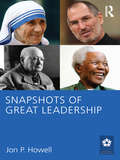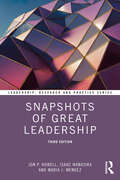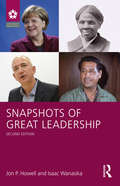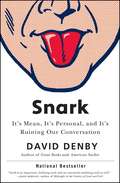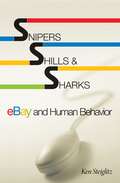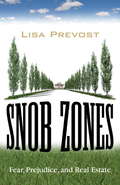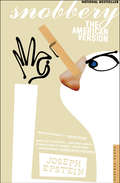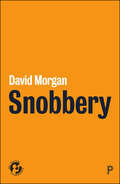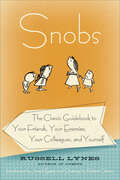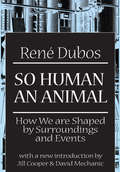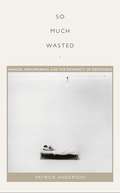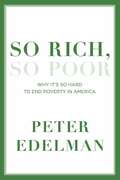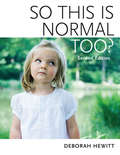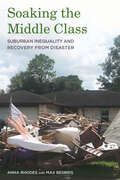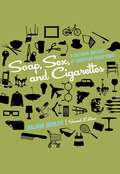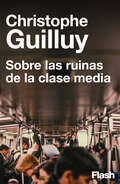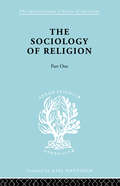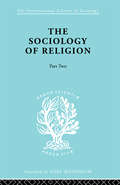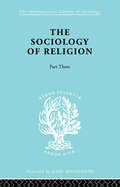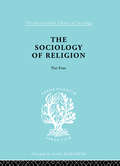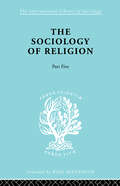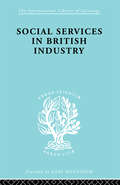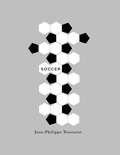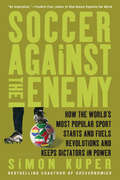- Table View
- List View
Snapshots of Great Leadership
by Jon P. HowellThis is a great book describing leaders (both good and bad) who either have accomplished amazing feats or who brought destruction or death to scores of people. Although the goals of these individuals were often quite different, the leadership processes they used were frequently similar. The book also includes an introductory chapter explaining the latest theories of leadership. Each snapshot will add an important “reality check” to the theories and models described in most introductory leadership textbooks, making this an important supplement for students taking leadership courses. Leaders from various disciplines, historical, religious, political, sports, and business, are included, as well as leaders from around the world. Each chapter ends with a discussion of theories of leadership pertaining to that leader, and questions for discussion.
Snapshots of Great Leadership (Leadership: Research and Practice)
by Jon P. Howell Isaac Wanasika Maria J. MendezSnapshots of Great Leadership offers a thorough look into leaders who have either accomplished amazing feats or brought destruction. Now in its third edition, this key volume explores what it means to be a great leader, and clearly explains the lives, triumphs, and challenges of a range of diverse leaders across history and into the modern day.Packed into easily digestible chapters, the authors demonstrate how, although the goals of these individuals were often quite different, the leadership processes they used were frequently similar. The opening chapter explains the latest theories of leadership and this new edition features one new leadership theory, Authentic Leadership, as well as recent research findings on the most popular theories. The authors have replaced nine leaders from earlier editions with new leaders including Elon Musk, Maria Montessori, and Virginia Hall. These new leaders exemplify unique leadership attributes and outstanding leadership effectiveness. Each leader snapshot adds an important "reality check" to the theories and models described in most introductory leadership textbooks, making this a key text for students taking leadership courses.Scholars and students of leadership and management will benefit from this accessible and comprehensive volume, as will leadership practitioners looking to reflect on and develop their own leadership skills. Offering valuable insights into the lives of historical and corporate leaders, the book is a compelling read for casual readers as well.
Snapshots of Great Leadership (Leadership: Research and Practice)
by Jon P. Howell Wanasika IsaacSnapshots of Great Leadership describes leaders who have either accomplished amazing feats or brought destruction. Although the goals of these individuals were often quite different, the leadership processes they used were frequently similar. The opening chapter explains the latest theories of leadership. Each leader snapshot adds an important "reality check" to the theories and models described in most introductory leadership textbooks, making this a key text for students taking leadership courses. This new edition features additional women and international leaders, a new "You Decide" section, and a Conclusion that clarifies the differences between good and bad leaders.
Snark
by David DenbyWhat is snark? You recognize it when you see it-- a tone of teasing, snide, undermining abuse, nasty and knowing, that is spreading like pinkeye through the media and threatening to take over how Americans converse with each other and what they can count on as true. Snark attempts to steal someone's mojo, erase her cool, annihilate her effectiveness. In this sharp and witty polemic, New Yorker critic and bestselling author David Denby takes on the snarkers, naming the nine principles of snark-- the standard techniques its practitioners use to poison their arrows.
Snipers, Shills, and Sharks: eBay and Human Behavior
by Ken SteiglitzEvery day on eBay, millions of people buy and sell a vast array of goods, from rare collectibles and antiques to used cars and celebrity memorabilia. The internet auction site is remarkably easy to use, which accounts in part for its huge popularity. But how does eBay really work, and how does it compare to other kinds of auctions? These are questions that led Ken Steiglitz--computer scientist, collector of ancient coins, and a regular eBay user--to examine the site through the revealing lens of auction theory. The result is this book, in which Steiglitz shows us how human behaviors in open markets like eBay can be substantially more complex than those predicted by standard economic theory. In these pages we meet the sniper who outbids you in an auction's closing seconds, the early bidder who treats eBay as if it were an old-fashioned outcry auction, the shill who bids in league with the seller to artificially inflate the price--and other characters as well. Steiglitz guides readers through the fascinating history of auctions, how they functioned in the past and how they work today in online venues like eBay. Drawing on cutting-edge economics as well as his own stories from eBay, he reveals practical auction strategies and introduces readers to the fundamentals of auction theory and the mathematics behind eBay. Complete with exercises and a detailed appendix, this book is a must for sophisticated users of online auctions, and essential reading for students seeking an accessible introduction to the study of auction theory.
Snob Zones
by Lisa PrevostAn exploration of the corrosive effects of overpriced housing, exclusionary zoning, and the flight of the younger population in the Northeast As anyone of moderate income who has wanted to buy a house or condo in the Northeast knows, young couples and families are increasingly being priced out of the market. And the housing crisis only drove up rents. As a result, young people are leaving the region entirely: six northeastern states now rank among the top ten nationally in age of their residents. In Snob Zones, Lisa Prevost argues that rising housing costs and a huge increase in restrictive zoning laws are undermining the very notion of community. Prevost illustrates this issue with eye-opening stories that illustrate the outrageous lengths to which towns will go to exclude the less affluent. She takes readers from notoriously upper-crust Darien, Connecticut, to a rural second-home town that is so restrictive its celebrity residents may soon outnumber its children and a northern lake community that brazenly deems itself out of bounds for apartment dwellers. This "every town for itself" mentality is threatening the social health and economic vitality of the region, argues Prevost in this thought-provoking exploration of what it means to be a community in post-recession America.
Snobbery: The American Version
by Joseph EpsteinObservations on the many ways we manage to look down on others, from &“a writer who can make you laugh out loud on every third page&” (The New York Times Book Review). Snobs are everywhere. At the gym, at work, at school, and sometimes even lurking in your own home. But how did we, as a culture, get this way? With dishy detail, Joseph Epstein skewers all manner of elitism as he examines how snobbery works, where it thrives, and the pitfalls and perils in thinking you&’re better than anyone else. Offering arch observations on the new footholds of snobbery, including food, fashion, high-achieving children, schools, politics, being with-it—whatever &“it&” is—name-dropping, and much more, Epstein explores the shallows and depths of a concept that has become part of our everyday lives . . . for better or worse. &“Smart, witty, perceptive . . . and almost always—in the best sense of the word—entertaining,&” Snobbery provides the ultimate social commentary on arrogance in America (TheWashington Post Book World). It&’s a book you shouldn&’t be caught dead without.
Snobbery: The practices of distinction (21st Century Standpoints)
by David MorganSnobbery is a more serious matter than some may think: the arguments around Brexit and Trump show that accusations of snobbery have become part of political discourse and public sentiment, building social divisions and reflecting deeper issues of class inequality. Social class is not simply about wealth, health and life-chances but also about everyday social experience, such as being included or excluded. As social inequality grows, snobbery is becoming ever more pertinent. This book takes a fresh and engaging look at this key issue, drawing on literature, popular culture and autobiography as well as sociology and history. David Morgan explores the complex history and different varieties of snobbery as well as its all-pervasive character to reveal why, despite claims about the openness of our society, it is still a matter of public concern.
Snobs: The Classic Guidebook to Your Friends, Your Enemies, Your Colleagues, and Yourself
by Russell LynesIn this classic work by the renowned wit and pundit whom the New York Times has lauded as "one of America's foremost arbiters of taste and mores . . . an acclaimed expert on what was highbrow, what was lowbrow, and what was no brow at all," the inimitable Russell Lynes flaunts (rather snobbishly, perhaps) his unparalleled expertise on all things snobbish. Since the Social Snob—with his raised nostrils and air of intolerable intolerance—has long since gone underground, it falls to a true connoisseur to identify the myriad faces of snobbery. Whether it be the Regional, Political, or Moral Snob, the Sensual or Sex Snob, or that most virulent of genus, the Reverse or Anti-Snob Snob, Lynes shines an illuminating light that will enable us to more easily recognize the pervasive pretentiousness surrounding us . . . and perhaps within us as well.
So Human an Animal: How We are Shaped by Surroundings and Events
by René DubosAt least until cloning becomes the order of the day, Rene Dubos contends that each human being is unique, unprecedented, unrepeatable. However, today each person faces the critical danger of losing this very humanness to his mechanized surroundings. Most people spend their days in a confusion of concrete and steel, trapped ""in the midst of noise, dirt, ugliness and absurdity."" So begins the essential message of the work of one of the great figures in microbiology and experimental pathology of this century.Is the human species becoming dehumanized by the condition of his environment? So Human an Animal is an attempt to address this broad concern, and explain why so little is being done to address this issue. The book sounds both an urgent warning, and offers important policy insights into how this trend towards dehumanization can be halted and finally reversed. Dubos asserts that we are as much the product of our total environment as of our genetic endowment. In fact, the environment we live in can greatly enhance, or severely Hmit, the development of human potential. Yet we are deplorably ignorant of the effects of our surroundings on human life. We create conditions which can only thwart human nature.So Human an Animal is a book with hope no less than alarm. As Joseph Wood Krutch noted at the time, Dubos shows convincingly ""why science is indispensable, not omnipotent."" Science'can change our suicidal course by learning to deal analytically with the living experience of human beings, by supplementing the knowledge of things and of the body machine with a science of human life. Only then can we give larger scope to human freedom by providing a rational basis for option and action. Timely, eloquent, and guided by a deep humanistic spirit, this new edition is graced by a succinct and careful outline of the life and work of the author.
So Much Wasted: Hunger, Performance, and the Morbidity of Resistance
by Patrick AndersonIn So Much Wasted, Patrick Anderson analyzes self-starvation as a significant mode of staging political arguments across the institutional domains of the clinic, the gallery, and the prison. Homing in on those who starve themselves for various reasons and the cultural and political contexts in which they do so, he examines the diagnostic history of anorexia nervosa, fasts staged by artists including Ana Mendieta and Marina Abramović, and a hunger strike initiated by Turkish prisoners. Anderson explores what it means for the clinic, the gallery, and the prison when one performs a refusal to consume as a strategy of negation or resistance, and the ways that self-starvation, as a project of refusal aimed, however unconsciously, toward death, produces violence, suffering, disappearance, and loss differently from other practices. Drawing on the work of Martin Heidegger, Sigmund Freud, Giorgio Agamben, Peggy Phelan, and others, he considers how the subject of self-starvation is refigured in relation to larger institutional and ideological drives, including those of the state. The ontological significance of performance as disappearance constitutes what Anderson calls the "politics of morbidity," the embodied, interventional embrace of mortality and disappearance not as destructive, but rather as radically productive stagings of subject formations in which subjectivity and objecthood, presence and absence, and life and death are intertwined.
So Rich, So Poor: Why It's So Hard to End Poverty in America
by Peter EdelmanThe author slashes through the myths of poverty and welfare in America, to highlight what has changed since the "War on Poverty" of Lyndon Johnson, and what doesn't work and why.
So This Is Normal Too?
by Deborah HewittTattling, aggression, and temper tantrums are examples of "normal" behaviors that can be difficult for teachers, caregivers, and families to handle. If ignored, these behaviors can grow into difficult, unappealing habits. So This Is Normal Too? Second Edition focuses on how teachers can observe and identify children who need more specific support and provides effective and practical solutions to guide children as they learn new skills and improve behaviors. Filled with child development information on twenty-one skills and behaviors, this resource links early learning standards to behavior and skill challenges. It also includes action planning forms and family handouts.
Soaking the Middle Class: Suburban Inequality and Recovery from Disaster
by Max Besbris Anna RhodesExtreme weather is increasing in scale and severity as global warming worsens. While poorer communities are typically most vulnerable to the negative effects of climate change, even well-resourced communities are increasingly vulnerable as climate-related storms intensify. Yet little is known about how middle-class communities are responding to these storms and the resulting damage. In Soaking the Middle Class, sociologists Anna Rhodes and Max Besbris examine how a middle-class community recovers from a climate-related disaster and how this process fosters inequality within these kinds of places. In 2017, Hurricane Harvey dropped record-breaking rainfall in Southeast Texas resulting in more than $125 billion in direct damages. Rhodes and Besbris followed 59 flooded households in Friendswood, Texas, for two years after the storm to better understand the recovery process in a well-resourced, majority-White, middle-class suburban community. As such, Friendswood should have been highly resilient to storms like Harvey, yet Rhodes and Besbris find that the recovery process exacerbated often-invisible economic inequality between neighbors. Two years after Harvey, some households were in better financial positions than they were before the storm, while others still had incomplete repairs, were burdened with large new debts, and possessed few resources to draw on should another disaster occur. Rhodes and Besbris find that recovery policies were significant drivers of inequality, with flood insurance playing a key role in the divergent recovery outcomes within Friendswood. Households with flood insurance prior to Harvey tended to have higher incomes than those that did not. These households received high insurance payouts, enabling them to replace belongings, hire contractors, and purchase supplies. Households without coverage could apply for FEMA assistance, which offered considerably lower payouts, and for government loans, which would put them into debt. Households without coverage found themselves exhausting their financial resources, including retirement savings, to cover repairs, which put them in even more financially precarious positions than they were before the flood. The vast majority of Friendswood residents chose to repair and return to their homes after Hurricane Harvey. Even this devastating flood did not alter their plans for long-term residential stability, and the structure of recovery policies only further oriented homeowners towards returning to their homes. Prior to Harvey, many Friendswood households relied on flood damage from previous storms to judge their vulnerability and considered themselves at low risk. After Harvey, many found it difficult to assess their level of risk for future flooding. Without strong guidance from federal agencies or the local government on how to best evaluate risk, many residents ended up returning to potentially unsafe places. As climate-related disasters become more severe, Soaking the Middle Class illustrates how inequality in the United States will continue to grow if recovery policies are not fundamentally changed.
Soap, Sex, and Cigarettes: A Cultural History of American Advertising (Second Edition)
by Juliann SivulkaSOAP, SEX AND CIGARETTES examines how American advertising both mirrors society and creates it. From the first newspaper advertisement in colonial times to today's online viral advertising, the text explores how advertising grew in America, how products and brands were produced and promoted, and how advertisements and agencies reflect and introduce cultural trends and issues. The threads of art, industry, culture, and technology unify the work. The text is chronological in its organization and is lavishly illustrated with advertisements.
Sobre las ruinas de la clase media
by Christophe GuilluyUn ensayo imprescindible para entender la sociedad actual en su totalidad. Este ensayo, que forma parte de la obra No society (Taurus), muestra como la desaparición de la clase media está estrechamente relacionada con la globalización y el drástico crecimiento del populismo. Así pues, fenómenos como el Brexit o Trump no son fruto de la irracionalidad, sino una consecuencia directa del modelo económico y social que, desde la segunda mitad del siglo XX, ha estado acabando la clase media. Esta ha sido sustituida por el mundo de las periferias, que actualmente abarca a la gran mayoría de grupos de la sociedad: desde los jubilados a los estudiantes. «La suma de los márgenes acaba por formar un todo: la sociedad.»
Soc & It's Envir: An Introduction
by TellegenFirst published in 1998. Routledge is an imprint of Taylor & Francis, an informa company.
Soc Relign Pt1: A Study Of Christendom (International Library of Sociology)
by Werner StarkPublished in 1998, Soc Relign Pt1: Est Relg IIs 79 is a valuable contribution to the field of Sociology & Social Policy.
Soc Relign Pt2: A Study Of Christendom (International Library of Sociology #9)
by Werner StarkFirst Published in 1998. Routledge is an imprint of Taylor & Francis, an informa company.
Soc Relign Pt3: A Study Of Christendom (International Library of Sociology)
by Werner StarkPublished in 1998, Soc Relign Pt3: Uni Chur IIs 81 is a valuable contribution to the field of Sociology & Social Policy.
Soc Relign Pt4: A Study Of Christendom (International Library of Sociology #9)
by Werner StarkFirst published in 1998. Routledge is an imprint of Taylor & Francis, an informa company.
Soc Relign Pt5: A Study Of Christendom (International Library of Sociology)
by Werner StarkPublished in 1998, Soc Relign Pt5: Typ Rel IIs 83 is a valuable contribution to the field of Sociology.
Soc Servcs Brit Indus Ils 192 (International Library of Sociology)
by A. F. YoungFirst Published in 1998. Routledge is an imprint of Taylor & Francis, an informa company.
Soccer
by Jean-Philippe ToussaintGrowing up in Belgium, soccer was Jean-Philippe Touissant’s life, a passion not shared by his bookish family. Now an acclaimed novelist, essayist, and filmmaker, he reflects upon his lifelong love for the game with an intellectual’s keen mind and a sports fan’s heart. What, he ponders, has a lifetime of soccer fandom taught him about life and the passage of time itself. Soccer takes readers on an idiosyncratic journey that delves deep into the author’s childhood memories, but also transports us to World Cup matches in Japan, Germany, South Africa, and Brazil. Along the way, it kicks around such provocative questions as: How does soccer fandom both support and transcend nationalism? How are our memories of soccer matches both collective and distinctly personal? And how can a game this beautiful and this ephemeral be adequately captured in words? Part travelogue, part memoir, and part philosophical essay, Soccer is entirely unique, a thrilling departure from the usual clichés of sports writing. Even readers with little knowledge of the game will be enthralled by Touissant’s profound musings and lyrical prose.
Soccer Against the Enemy: How The World's Most Popular Sport Starts And Fuels Revolutions And Keeps Dictators In Power
by Simon KuperSoccer is much more than just the most popular game in the world. It is a matter of life and death for millions around the world, an international lingua franca. Simon Kuper traveled to twenty-two countries to discover the sometimes bizarre effect soccer can have on politics and culture. At the same time he tried to discover what makes different countries play a simple game so differently. Kuper meets a remarkable variety of fans along the way, from the East Berliner persecuted by the Stasi for supporting his local team, to the Argentine general with his own views on tactics. He also illuminates the frightening intersection between soccer and politics, particularly in the wake of the attacks of 9-11, where soccer is obsessed over by the likes of Osama bin Laden. The result is one of the world's most acclaimed books on the game, and an astonishing study of soccer and its place in the world.
